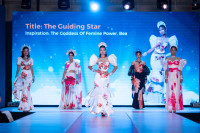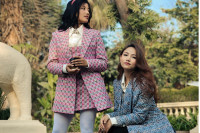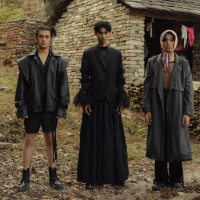Fashion
Beauty pageant costumes keep repeating and they’re starting to become boring
Nepali designers are dressing beauty pageant winners in extraordinary attire, but the same theme in most designs reflects a lack of originality..jpg&w=900&height=601)
Ankit Khadgi
Last week, fashion designer Manish Rai posted a video on Instagram showing this year’s Miss Nepal donning a costume representing Vajrayogini, a Buddhist deity. Wearing an embellished bikini top and a matching skirt, he introduced Pradeepta Adhikari’s ‘national costume’ for the upcoming international pageant.
The concept of the costume, which is described in the caption of the video, is however, very similar to the one worn by two former Miss Universe Nepal winners. Nagma Shrestha, who was the first ever contestant from Nepal to participate in the Miss Universe pageant, had donned an elaborate headgear representing the Basundhara mandala, while her white costume embodied the style of a Buddhist deity.
“I believe I did something different. But since then, similar themes have been followed,” says Shrestha, who represented Nepal at the pageant in 2017. “I wish they were taking more risks and making more extravagant designs.”
Before Shrestha and her team decided to experiment with the design, Nepali beauty pageant participants were limited to costumes featuring dhaka fabric, rhododendron flowers or gunyu cholo. This was a trend for a long time, with Nepali contestants wearing almost identical costumes year after year.
In Nepal, beauty pageants have served as a platform even for Nepali designers to highlight their creations. And with the unveiling of Shrestha’s costume, it seemed as though the Nepali fashion industry was opening doors for unique and original design ideas. But the duplication of the same concept for the last two years has dampened the mood for many fashion conscious Nepalis who want to see local designers experiment with creativity and originality.
“We can’t just rely on outdated fabrics and the same old pallets,” says Bina Ghale, who had designed Shrestha’s national costume for Miss Universe pageant. “As designers, we should be able to anticipate the future trends. It is necessary to come up with unique designs in addition to being flashy.”
Miss Universe Nepal 2018 winner wore a costume inspired from Avalokitesvara, a Bodhisattva, for the international pageant last year. Both Miss International Nepal 2018 and Miss Nepal Supranational 2019 winners wore a costume inspired by Green Tara, a Buddhist bodhisattva for their respective international events.
Rai, who designed Adhikari’s costume, and has been the in-house designer for the Miss Nepal event for the last two years, says these designs are not easy to make and he did detailed research for them.
“It took me three months to make Pradeepta’s costume. We did proper research about how we can work on the costume and justify the theme,” says Rai. “I also studied her personality to match the outfit.”
Rai’s argument, however, stands strong for Miss International Nepal 2016, Barsha Lekhi, who was dressed in an elegant garb inspired by a Tharu dress. Rather than going for the similar themes and designs of goddesses and deities, she decided to showcase her roots.
“The repetitive designs do not do our cultural diversity justice,” says Shrestha, the 2017 pageant winner. “It is important to break the stereotype.” The lack of diversity in costumes is also the result of pageant winners coming from the same socio-cultural background, according to fashion stylist Rhea Pradhan. The creative decision for any national costume is a teamwork, including the contestants, designers and artists responsible for accessories. So, many of the concepts and designs are repeated as they are unable to think beyond their limited circle and exposure.
“Another main reason why they are incorporating such elements is because they can be easily recognised by everyone,” says Pradhan. “But yes, most of the Miss Nepals seem to be replicating each other’s thought process in many things.”
To put Pradhan’s case in point, Miss Asia-Pacific International Nepal 2018 Aastha Saakha, Miss Grand International 2018 Urussa Joshi and Miss Earth Nepal 2017 Rojina Shrestha, all of them wore costumes inspired by Goddess Kumari.
But Saakha says she had to resort to wearing the costume because of a lack of time and funds to prepare for the international event.
“Apart from the national costume, I had to prepare my evening gown, swimwear and outfits for other side events.” she says. “Another challenge is not having an airline sponsor, which restricts us from carrying heavier dresses or accessories.”
Sakil Kunwar, creative director of popular makeup studio BLISS, who also served as pageant trainer for Shrestha, agrees with Saakha. “There are financial limitations when it comes to Nepali pageant winners participating in international events,” he says.
But he remains hopeful that other aspects of Nepali culture and history will be researched and executed in the future with the way creative processes are taken into consideration in recent years. Although he agrees that there are similarities in designs, he is content with the variation within the similar themes for now.
“They sometimes might have the same concept, but the execution is different,” he says.
In recent years, Nepali beauty pageants have been garnering a larger of fan following, with a number of social media accounts purely dedicated to following the pageant winners into various international events. This has also been beneficial to Nepali designers for showcasing their creations.
“Designers should be willing to take risks and showcase the diversity of Nepali culture in international events,” says George Gurung, admin of Official Nepali Beauty, an Instagram handle dedicated to beauty pageants. “The era of social media is fertile ground for the evolution of Nepali fashion industry and building fashion as an aesthetic art form.”
Rai says he has been continuously exploring Nepal’s history and culture for pageants contestants, and hopes to push his own envelopes in future projects.
“Creativity and art has no boundaries,” he says.




 8.12°C Kathmandu
8.12°C Kathmandu










